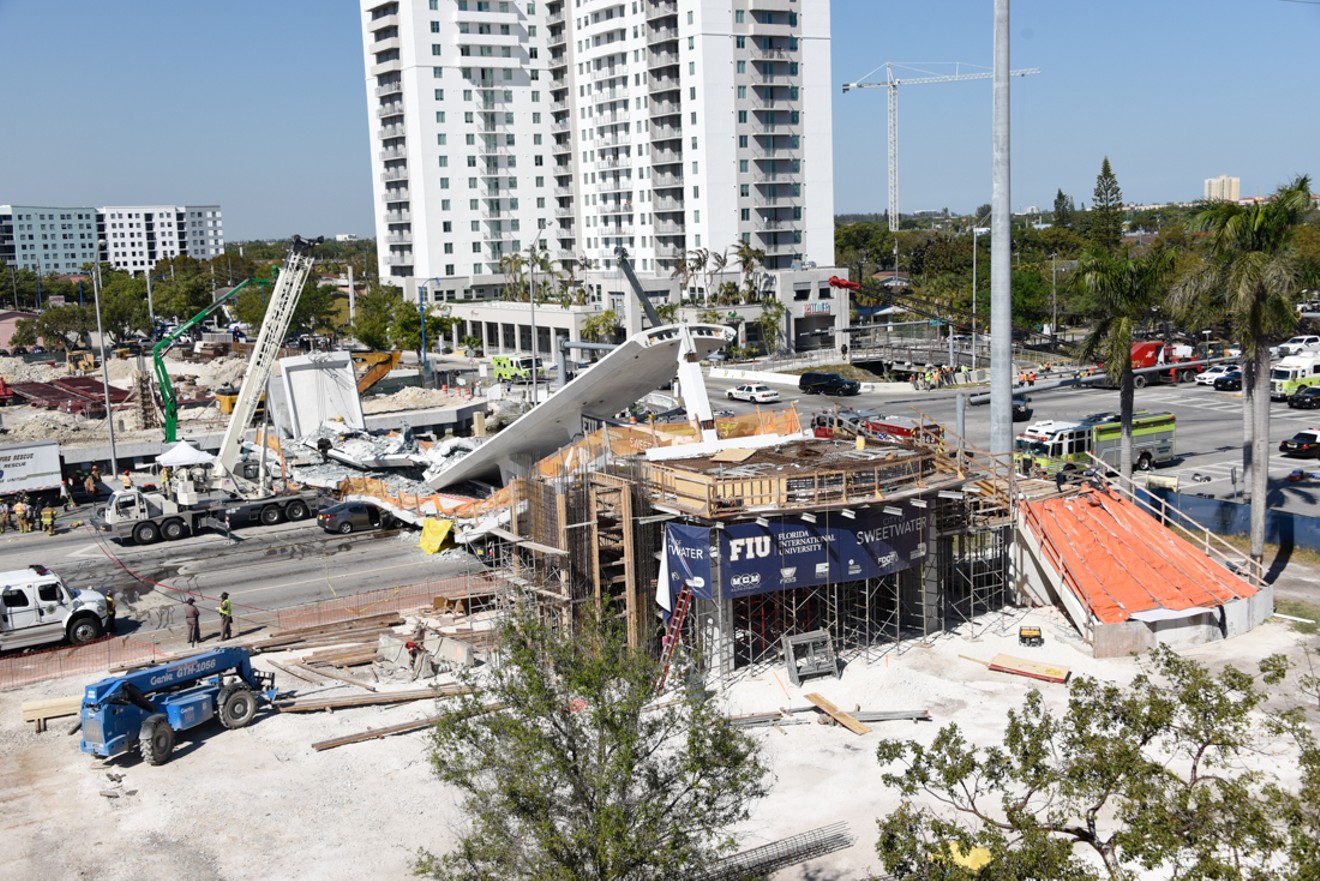It's now clear that the pedestrian bridge at Florida International University collapsed and killed six people after engineers put it through some kind of "stress testing" earlier in the day. According to Sen. Marco Rubio, the bridge's internal support cables were being "tightened" just as the bridge crumbled onto traffic below, crushing eight cars under 950 tons of concrete and steel.
But no one has yet explained why cars were allowed to drive freely under an incomplete bridge while workers were testing to see if it might fall apart. Now, some local officials are demanding answers.
Miami-Dade County Commissioner Xavier Suarez, who has a background in civil engineering, said he was flabbergasted that SW Eighth Street was not shut down to traffic before or during any stress tests or cable adjustments on the unfinished project.
"Never in my life have I heard of that," Suarez said. "That makes no sense. That makes no sense."
So who signed off on letting cars drive underneath this bridge, apparently while stress tests were ongoing?
The City of Sweetwater, where the bridge collapsed, said it had no say in the matter. Instead, the construction firm, Munilla Construction Management (MCM), and the Florida Department of Transportation (FDOT) made the call, it says.
"We were never involved in any decisions about the streets," says Sandy Antonio, a spokesperson for the city. "The construction company worked directly with FDOT on getting approval to shut down the street."
In fact, SW Eighth Street was closed this past weekend while the bridge was swung into place using a modern technique developed at FIU's Accelerated Bridge Construction University Transportation Center. The road was closed from 9 p.m. Friday until 5 a.m. Monday.
FDOT simply informed Sweetwater about the closures so police could avoid traffic jams, Antonio says.
"The only involvement we had was understanding when it was shut down and when it would reopen," she says. "That was all determined by the construction company and FDOT."
Neither MCM nor FDOT returned messages from New Times today. The Miami-Dade County Department of Transportation and Public Works also did not respond to requests for comment.
Dr. Amjad Aref, a civil engineer and researcher at the University of Buffalo's Institute of Bridge Engineering, tells New Times it's not unheard-of to let traffic flow during a stress test under some conditions, especially if the testing is minor. But in cases where a bridge is not complete, he says, there is typically a plan to keep pedestrians, motorists, construction workers, and the general public out of harm's way.Collapse of a brand-new pedestrian bridge w/o pedestrians on it @ FIU makes no sense. I will not accept explanation based on "testing." U cannot "test" bridge when people are driving below it. I want 2 know what failed - support or span? Either way, somebody was beyond negligent.
— Xavier L. Suarez (@XavierLSuarez1) March 16, 2018
"Normally when we do anything, even a fairly completed bridge or if it's some rehab or even really minor load-testing, there's some sort of traffic control," Aref says.
He adds that many bridges are typically tested in a lab setting before being installed. Even in labs, he says, engineers are supposed to take every precaution to ensure that people nearby won't get hurt by debris if the structure caves in.
However, he stresses that the investigation into what went wrong at FIU is still early and that it's unclear what, if any, precautions might have been in place before the accident.
"Even when we do loading in a lab setting, safety is the first thing we think about," he says. "So it doesn’t matter if it's a highway bridge or in a controlled environment, you're thinking safety, safety. So I am sure the investigators will come to find the reasons that no precautions were made for traffic."
Update: In a lengthy statement, FDOT defended its handling of the bridge building and street closures, noting that:
FDOT also released the full transcript of a call Figg's lead engineer for the project left on a voicemail at the department on Tuesday — two days before the collapse. The engineer notes that there's "some cracking that’s been observed on the north end of the span, the pylon end of that span we moved this weekend," and adds that "obviously some repairs or whatever will have to be done but from a safety perspective we don’t see that there’s any issue there so we’re not concerned about it from that perspective although obviously the cracking is not good and something’s going to have to be, ya know, done to repair that."
"According to standard procedures, FDOT issued a permit at the request of FIU’s design build team to close SW 8th Street during the installation of the FIU pedestrian bridge on Saturday, March 10. While FDOT has issued, following a request from the FIU design build team, a blanket permit allowing for two-lane closures effective from January through April, at no time, from installation until the collapse of the bridge, did FDOT receive a request to close the entire road. The department was also not made aware by the FIU design build team of any scheduled “stress testing” of the bridge following installation and has no knowledge or confirmation from FIU’s design build team of “stress testing” occurring since installation. Per standard safety procedure, FDOT would issue a permit for partial or full road closure if deemed necessary and requested by the FIU design build team or FIU contracted construction inspector for structural testing."
FDOT says the message was left on a voicemail that wasn't checked until Friday because the employee was out of the office.
The department says one of its consultants attended a meeting with FIU's build team on Thursday "shortly before the bridge failure" and that the consultant was "not notified of any life-safety issues, need for additional road closures or requests for any other assistance from FDOT."
FDOT emphatically points the finger at FIU's team for any failures in the bridge:
The responsibility to identify and address life-safety issues and properly communicate them is the sole responsibility of the FIU design build team. At no point during any of the communications above did FIGG or any member of the FIU design build team ever communicate a life-safety issue. Again, FIGG and the FIU design build team never alerted FDOT of any life-safety issue regarding the FIU pedestrian bridge prior to collapse.













